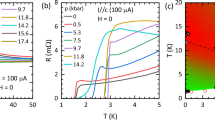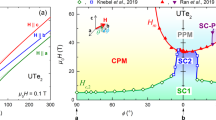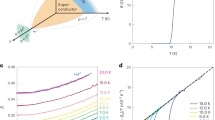Abstract
When a pure material is tuned to the point where a continuous phase-transition line is crossed at zero temperature, known as a quantum critical point (QCP), completely new correlated quantum ordered states can form1,2,3,4,5,6,7. These phases include exotic forms of superconductivity. However, as superconductivity is generally suppressed by a magnetic field, the formation of superconductivity ought not to be possible at extremely high field8. Here, we report that as we tune the ferromagnet, URhGe, towards a QCP by applying a component of magnetic field in the material’s easy magnetic plane, superconductivity survives in progressively higher fields applied simultaneously along the material’s magnetic hard axis. Thus, although superconductivity never occurs above a temperature of 0.5 K, we find that it can survive in extremely high magnetic fields, exceeding 28 T.
This is a preview of subscription content, access via your institution
Access options
Subscribe to this journal
Receive 12 print issues and online access
$259.00 per year
only $21.58 per issue
Buy this article
- Purchase on SpringerLink
- Instant access to full article PDF
Prices may be subject to local taxes which are calculated during checkout



Similar content being viewed by others
References
Jaccard, D., Behnia, K. & Sierro, J. Pressure induced heavy fermion superconductivity of CeCu2Ge2 . Phys. Lett. A 163, 475–480 (1992).
Mathur, N. D. et al. Magnetically mediated superconductivity in heavy fermion compounds. Nature 394, 39–43 (1998).
Harrison, N., Jaime, M. & Mydosh, J. A. Re-entrant hidden order at a metamagnetic quantum critical end point. Phys. Rev. Lett. 90, 96402 (2003).
Lévy, F., Sheikin, I., Grenier, B. & Huxley, A. D. Magnetic field-induced superconductivity in the ferromagnet URhGe. Science 309, 1343–1346 (2005).
Park, T. et al. Hidden magnetism and quantum criticality in the heavy fermion superconductor CeRhIn5 . Nature 440, 65–68 (2006).
Knebel, G., Aoki, D., Braithwaite, D., Salce, B. & Flouquet, J. Coexistence of antiferromagnetism and superconductivity in CeRhIn5 under high pressure and magnetic field. Phys. Rev. B 74, 020501R (2006).
Borzi, R. A. et al. Formation of a nematic fluid at high fields in Sr3Ru2O7. Science 315, 214–217 (2007)
Coleman, P. & Schofield, A. J. Quantum criticality. Nature 433, 226–299 (2005).
Roussev, R. & Millis, A. J. Quantum critical effects on transition temperature of magnetically mediated p-wave superconductivity. Phys. Rev. B 63, 140504 (2001).
Fay, D. & Appel, J. Coexistence of p-state superconductivity and itinerant ferromagnetism. Phys. Rev. B 22, 3173–3182 (1980).
Monthoux, P. & Lonzarich, G. G. p and d-wave superconductivity in quasi-two-dimensional metals. Phys. Rev. B 59, 14598–14605 (2001).
Millis, A. J., Sachdev, S. & Varma, C. M. Inelastic scattering and pair breaking in anisotropic and isotropic superconductors. Phys. Rev. B 37, 4975–4986 (1988).
Kawasaki, S. et al. New superconducting and magnetic phases emerge on the magnetic criticality in CeIn3 . J. Phys. Soc. Japan 73, 1647–1650 (2004).
Sheikin, I. et al. Superconductivity, upper critical field and anomalous normal state in CePd2Si2 near the quantum critical point. J. Low Temp. Phys. 122, 591–604 (2001).
Aoki, D. et al. Coexistence of superconductivity and ferromagnetism in URhGe. Nature 413, 613–616 (2001).
Belitz, D., Kirkpatrick, T. R. & Rollbühler, J. Tricritical behavior in itinerant quantum ferromagnets. Phys. Rev. Lett. 94, 24706 (2005).
Hardy, F. & Huxley, A. D. p-wave superconductivity in the ferromagnetic superconductor URhGe. Phys. Rev. Lett. 94, 247006 (2005).
Prohammer, M. & Carbotte, J. P. Upper critical field of s- and d-wave superconductors with anisotropic effective mass. Phys. Rev. B 42, 2032–2040 (1990).
Kita, T. & Arai, M. Ab initio calculations of Hc2 in type-II superconductors: Basic formalism and model calculations. Phys. Rev. B 70, 224522 (2004).
Werthamer, N. R. & McMillan, W. L. Temperature and purity dependence of the superconducting critical field, Hc2. IV. Strong coupling effects. Phys. Rev. 158, 415–417 (1967).
Scharnberg, K. & Klemm, R. A. Upper critical field in p-wave superconductors with broken symmetry. Phys. Rev. Lett. 54, 2445–2448 (1985).
Gegenwart, P. et al. Magnetic-field induced quantum critical point in YbRh2Si2 . Phys. Rev. Lett. 89, 056402 (2002).
Custers, J. et al. The break-up of heavy electrons at a quantum critical point. Nature 424, 524–527 (2003).
Lonzarich, G. G. in Electron, a Centenary Volume (ed. Springford, M.) 109–147 (Cambridge Univ. Press, Cambridge, 1997).
Paulsen, C. et al. Low temperature properties of the heavy-fermion compound CeRu2Si2 at the metamagnetic transition. J. Low Temp. Phys. 81, 317–339 (1990).
Borzi, R. A. et al. de Haas-van Alphen effect across the metamagnetic transition in Sr3Ru2O7 . Phys. Rev. Lett. 92, 216403 (2004).
Grigera, S. A. et al. Disorder-sensitive phase formation linked to metamagnetic quantum criticality. Science 306, 1154–1157 (2004).
Acknowledgements
Financial support was provided for work at the GHMFL from the European Commission. A.H. gratefully acknowledges support from the Royal Society, UK.
Author information
Authors and Affiliations
Corresponding author
Ethics declarations
Competing interests
The authors declare no competing financial interests.
Rights and permissions
About this article
Cite this article
Lévy, F., Sheikin, I. & Huxley, A. Acute enhancement of the upper critical field for superconductivity approaching a quantum critical point in URhGe. Nature Phys 3, 460–463 (2007). https://doi.org/10.1038/nphys608
Received:
Accepted:
Published:
Issue Date:
DOI: https://doi.org/10.1038/nphys608



